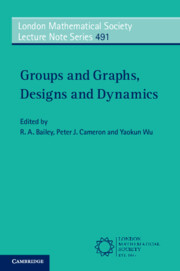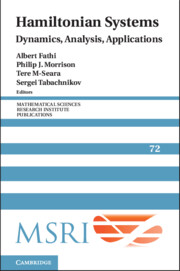Refine search
Actions for selected content:
28972 results in Differential and integral equations, dynamical systems and control theory
JAZ volume 116 issue 3 Cover and Front matter
-
- Journal:
- Journal of the Australian Mathematical Society / Volume 116 / Issue 3 / June 2024
- Published online by Cambridge University Press:
- 13 May 2024, pp. f1-f2
- Print publication:
- June 2024
-
- Article
-
- You have access
- Export citation
Complexity of non-abelian cut-and-project sets of polytopal type I: special homogeneous Lie groups
- Part of
-
- Journal:
- Ergodic Theory and Dynamical Systems / Volume 45 / Issue 1 / January 2025
- Published online by Cambridge University Press:
- 13 May 2024, pp. 175-217
- Print publication:
- January 2025
-
- Article
-
- You have access
- Open access
- HTML
- Export citation
INDEX
-
- Journal:
- Journal of the Australian Mathematical Society / Volume 116 / Issue 3 / June 2024
- Published online by Cambridge University Press:
- 13 May 2024, p. 399
- Print publication:
- June 2024
-
- Article
- Export citation

Groups and Graphs, Designs and Dynamics
-
- Published online:
- 11 May 2024
- Print publication:
- 30 May 2024

Hamiltonian Systems
- Dynamics, Analysis, Applications
-
- Published online:
- 10 May 2024
- Print publication:
- 09 May 2024
INDEX
-
- Journal:
- The ANZIAM Journal / Volume 65 / Issue 4 / October 2023
- Published online by Cambridge University Press:
- 10 May 2024, pp. 411-412
-
- Article
- Export citation
ANZ VOLUME 65 ISSUE 4 COVER AND FRONT MATTER
-
- Journal:
- The ANZIAM Journal / Volume 65 / Issue 4 / October 2023
- Published online by Cambridge University Press:
- 10 May 2024, pp. f1-f2
-
- Article
-
- You have access
- Export citation
On conformally flat minimal Legendrian submanifolds in the unit sphere
- Part of
-
- Journal:
- Proceedings of the Royal Society of Edinburgh. Section A: Mathematics , First View
- Published online by Cambridge University Press:
- 10 May 2024, pp. 1-30
-
- Article
- Export citation
ANZ VOLUME 65 ISSUE 4 COVER AND BACK MATTER
-
- Journal:
- The ANZIAM Journal / Volume 65 / Issue 4 / October 2023
- Published online by Cambridge University Press:
- 10 May 2024, pp. b1-b4
-
- Article
-
- You have access
- Export citation
Catenaries and minimal surfaces of revolution in hyperbolic space
- Part of
-
- Journal:
- Proceedings of the Royal Society of Edinburgh. Section A: Mathematics , First View
- Published online by Cambridge University Press:
- 10 May 2024, pp. 1-21
-
- Article
-
- You have access
- Open access
- HTML
- Export citation
Co-spectral radius for countable equivalence relations
- Part of
-
- Journal:
- Ergodic Theory and Dynamical Systems / Volume 44 / Issue 12 / December 2024
- Published online by Cambridge University Press:
- 10 May 2024, pp. 3385-3427
- Print publication:
- December 2024
-
- Article
-
- You have access
- Open access
- HTML
- Export citation
Surfaces of locally minimal flux
-
-
- Book:
- Hamiltonian Systems
- Published online:
- 10 May 2024
- Print publication:
- 09 May 2024, pp 215-228
-
- Chapter
- Export citation
Contents
-
- Book:
- Hamiltonian Systems
- Published online:
- 10 May 2024
- Print publication:
- 09 May 2024, pp vii-viii
-
- Chapter
- Export citation
Denjoy subsystems and horseshoes
-
-
- Book:
- Hamiltonian Systems
- Published online:
- 10 May 2024
- Print publication:
- 09 May 2024, pp 1-28
-
- Chapter
- Export citation
Impact Hamiltonian systems and polygonal billiards
-
-
- Book:
- Hamiltonian Systems
- Published online:
- 10 May 2024
- Print publication:
- 09 May 2024, pp 29-66
-
- Chapter
- Export citation
Frontmatter
-
- Book:
- Hamiltonian Systems
- Published online:
- 10 May 2024
- Print publication:
- 09 May 2024, pp i-vi
-
- Chapter
- Export citation
Holonomy and vortex structures in quantum hydrodynamics
-
-
- Book:
- Hamiltonian Systems
- Published online:
- 10 May 2024
- Print publication:
- 09 May 2024, pp 173-214
-
- Chapter
- Export citation
Hamiltonian ODE, homogenization, and symplectic topology
-
-
- Book:
- Hamiltonian Systems
- Published online:
- 10 May 2024
- Print publication:
- 09 May 2024, pp 297-367
-
- Chapter
- Export citation
Viscosity solutions of the Hamilton–Jacobi equation on a noncompact manifold
-
-
- Book:
- Hamiltonian Systems
- Published online:
- 10 May 2024
- Print publication:
- 09 May 2024, pp 111-172
-
- Chapter
- Export citation
Some remarks on the classical KAM theorem, following Pöschel
-
-
- Book:
- Hamiltonian Systems
- Published online:
- 10 May 2024
- Print publication:
- 09 May 2024, pp 67-74
-
- Chapter
- Export citation











